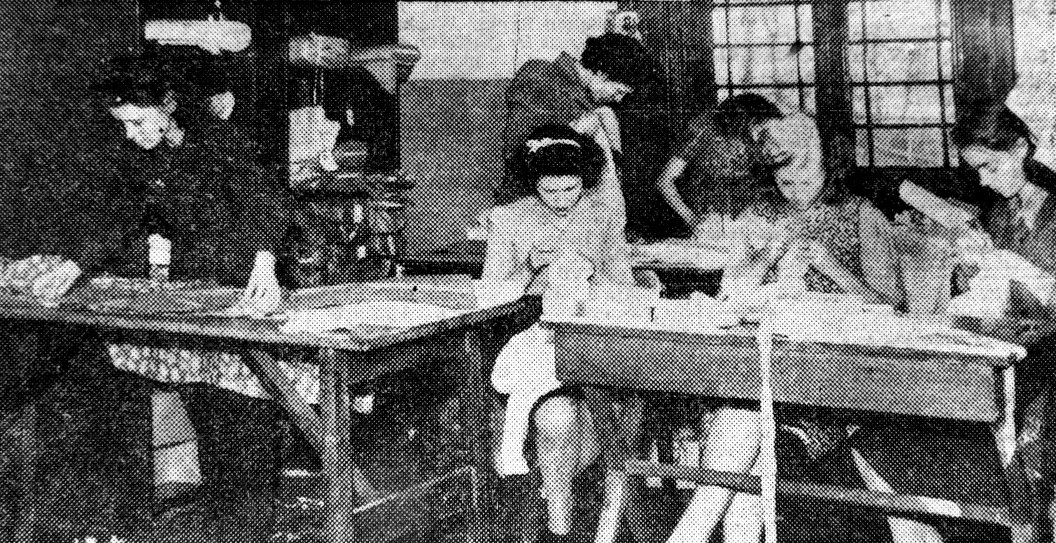South Yorkshire Times, March 13, 1948
Beauty and Utility
Industry Compromises with History
THE grey stone walls of Bolton’s handsome old hall, once the background of eighteenth century family life, now resound to the hum of sewing machines and the eager chatter of miners’ daughters.
Nine months ago the hall, derelict after its wartime occupation as headquarters, after Dunkirk, of the famous No. 1 Army Corps, lay desolate. Whole windows were few, the grounds a wilderness, and the fine old oak woodwork inside the house hidden in grime. Now the building, dating back to 1783, stands resplendent, in new dress of gold and green.
To-day the old hall is a gown factory.

Transformation
The story of this transformation was told me on Monday by Mr F. Boardman, a principal of the Derby firm of gown manufacturers L. and F. Boardman who on October 31st took over the hall and the 2 acres of grounds which they had purchased from Dearne Urban CouPnucri-1 e earlier in the year. Work of furbishing was already in progress. Now it is almost complete.
Forbidden to extend their premises in Derby — ‘You must bring your factory to the labour,” the Government say—Mr and Mrs Boardman I were directed by the Board of Trade to Yorkshire. In Dearne they inspected various factory sites, and eventually reached neglected tumbling down Bolton Hall.
“My wife was kind of attracted to the place,” Mr Boardman said. “I am afraid I did not appreciate its possibilities. Everything was inches deep under dust and water had penetrated into the building from the roof, but Mrs Boardman recognised what could be done, and, well, here we are.”
Mr and Mrs Boardman have recreated something more than a building. They have re-established the tradition of the place. Gone is the sense of unkempt neglect; once again there is an air about the whole premises that they had been restored for their own sake as well as for material means.
Instruction
The former lounge and dining room, dignified and stately with their large, stone-framed windows, now houses 22 girls and young married women under instruction, from Mrs Boardman in the mysteries of gown-making. They sit in the lofty room—the wooden partition which separated the rooms in days gone by has been removed – and the sun streams in. Decorations is in light green and gold, and outside a gardener is making broad walks and soon lawn will stretch to the extremity of the site.
A revolving summer-house has been erected and plans are being considered for the provision of a tennis court.
Part of the whole Mr and Mrs Boardman are using is a flat, but all the other rooms being given over to the various processes of dress manufacture. Upstairs is the designing and pattern room, another room will be given over to finishing. Downstairs the cutting machine will be housed in what used to be the butler’s pantry and the kitchen. From the kitchen a massive firework and oven has been removed
Further machines are to be installed in the former lounge and dining room, and eventually it is hoped to employ 60 girls. All the present employees are from Bolton, Goldthorpe and Thurnscoe. A rest room has been provided and it is hoped that the canteen will be in operation next week.
Visitors to the entrance hall, crowned by a glorious oak stairway, magnificent after its restoration, will find a memory of the war. The entrance hall is to be reception and show room, and embellishing the room will be a stone fireplace, moved by Mr and Mrs Boardman from the lounge.
“This fireplace was built,” Mr Boardman explained, “by a soldier who was stationed in the hall during the war. All the stones were gathered from parts of the premises; and cut and shaped by this soldier-mason.” The result is a handsome addition to the premises.
From May, 1941, to the end of 1943 or early 1944, the Hall, once the residence of Mr Alfred Clegg, Barnsley solicitor, and later the King men’s club, served as No.1 Corps headquarters.
Today, on the lintel above the door of the entrance hall, hangs a lonely shield, bearing a proud eagle, insignia of one of the Army units. This is all that is left of that wartime occupation
It looks down on the well-tended drive and the crocuses that have taken the place of the tanglewood of elder trees. All is quiet, only the hum of the machines coming, faintly from the other side of the house reveals that one more of our stately homes has been restored.— for industry.